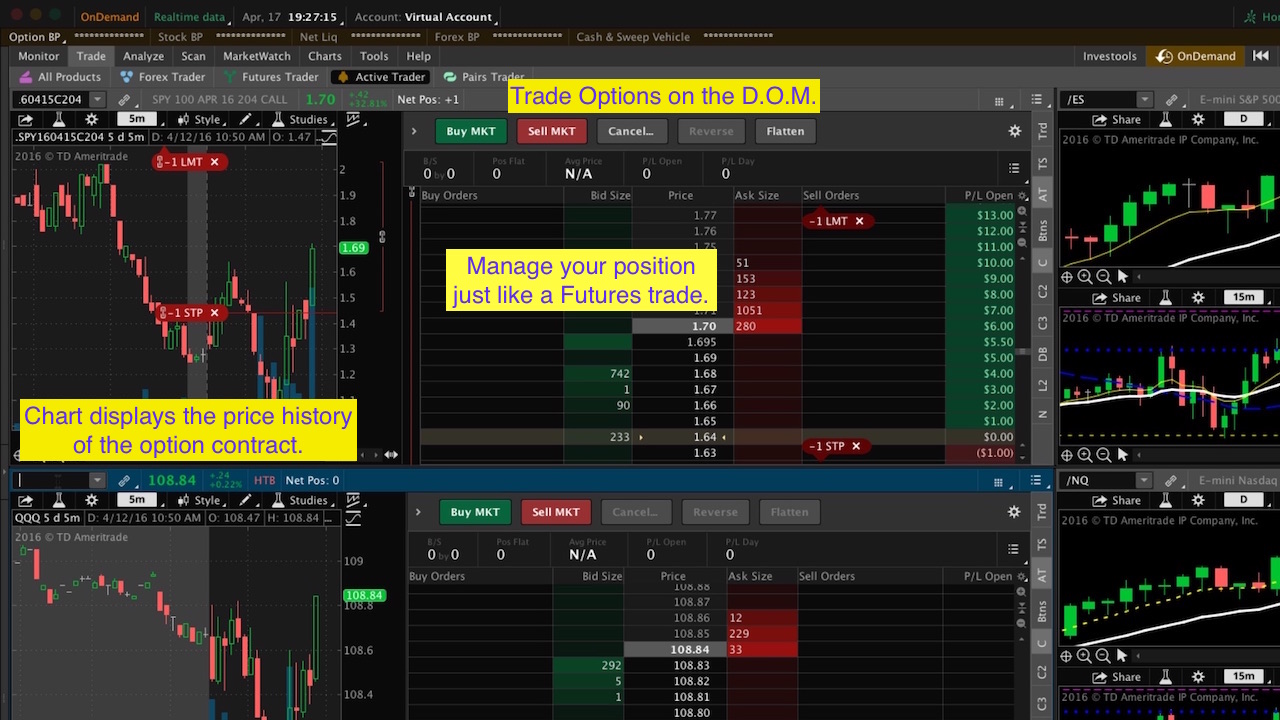Are you ready to unlock the world of options trading with Thinkorswim? Dive into our comprehensive guide and master the art of profiting from market fluctuations. Whether you’re a seasoned trader or just starting out, this article will provide you with a step-by-step roadmap to success.

Image: www.youtube.com
Navigating Thinkorswim’s Options Trading Platform
Thinkorswim’s user-friendly interface makes it a breeze to navigate and execute options trades. Upon logging in, you’ll find the “Options Chain” tab, your gateway to a wealth of options data. This tab displays the available options contracts for a specific underlying asset (e.g., a stock, ETF, or index), along with their key attributes (expiration date, strike price, premium, etc.).
To purchase an option, simply click on the desired contract and select “Buy” or “Sell” from the drop-down menu. The “Order Entry” window allows you to customize your order parameters, including the number of contracts, limit price, and stop price, ensuring precise execution of your trades.
Understanding Options Trading
Options are financial contracts that grant you the right to buy or sell an underlying asset at a predetermined price (strike price) on or before a specific date (expiration date). There are two main types of options: calls and puts.
Call options give you the right to buy the underlying asset at the strike price, while put options provide the right to sell. If the underlying asset’s price moves favorably towards your expected direction, your options will increase in value, giving you the potential to profit. However, if the market moves against you, your options may lose value, resulting in potential losses.
Step-by-Step Option Trading Process
- Select an underlying asset: Identify the stock, ETF, or index you want to trade options on, based on your market research and analysis.
- Choose an option: Determine if you want to buy a call option (expecting a price increase) or a put option (expecting a price decrease).
- Set your parameters: Select the strike price, expiration date, and contract size that align with your trading strategy.
- Place your order: Enter your order details into the “Order Entry” window, including the number of contracts, order type (market or limit), and optional stop loss or limit triggers.
- Monitor your positions: Once your trade is executed, keep track of its performance using the “Positions” tab, which provides real-time updates on your options contracts’ values.

Image: globaltradingsoftware.com
Expert Tips and Advice for Successful Option Trading
Trading options successfully requires skill, knowledge, and a strategic approach. Here are some tips and advice from seasoned traders:
- Educate yourself: Thoroughly understand the concepts and mechanics of options trading before you start trading with real money.
- Manage risk: Limit your positions to an amount of risk that you’re comfortable losing, and consider using stop-loss orders to protect your capital.
- Be patient: Options trading requires patience, as markets can fluctuate unpredictably. Don’t expect to become rich overnight.
- Follow the trend: Identify the prevailing market trend and trade options that align with it to increase your chances of success.
- Seek advice: Consider consulting with a financial advisor or joining online trading communities to gain insights and exchange strategies.
Frequently Asked Questions
- What is the difference between a call option and a put option?
A call option grants the right to buy an asset, while a put option gives the right to sell an asset.
- How do I profit from options trading?
You profit by buying an option at a lower price and selling it at a higher price or by exercising the option to buy or sell the underlying asset at a favorable price.
- What are the risks involved in options trading?
The potential downside in options trading is that you could lose the entire amount you invested in the option premium, especially if the market moves against your expectations.
- How can I learn more about options trading?
There are numerous online resources, books, and educational platforms that provide comprehensive information and training on options trading.
- Is options trading a suitable investment for beginners?
Options trading can be complex and risky, and it’s recommended for experienced investors who have a good understanding of financial markets.
Step By Step Thinkorswim Option Trading

Image: www.hahn-tech.com
Conclusion
Mastering Thinkorswim option trading empowers you to leverage market fluctuations and potentially generate significant returns. By following the step-by-step process outlined in this guide, coupled with expert advice and a disciplined trading approach, you can increase your chances of success in the dynamic world of options trading.
Are you ready to embark on the exciting journey of options trading with Thinkorswim? Join the ranks of successful traders and take control of your financial future.






